Parameter Optimization and Control Strategy of Hybrid Electric Vehicle Transmission System based on Improved GA Algorithm
Abstract
1. Introduction
2. Related Works
3. HEV Transmission System Control Optimization Method Based on Improved GA Algorithm
3.1. Construction of HEV Parameter Matching Model
3.2. HEV Transmission System Parameter Optimization Method based on PSO-GA Algorithm
4. Application Analysis of PSO-GA in HEV Transmission System Parameter Optimization
4.1. Simulation Experiment Analysis of HEV Model
4.2. Performance Comparison and Analysis of Hybrid Power Parameter Optimization Algorithms
5. Conclusions
Author Contributions
Funding
Data Availability Statement
Conflicts of Interest
References
- Li, S.Q.; Yu, B. Matching design and simulation for power train parameter of pure electric vehicle based on cruise. For. Eng. 2019, 35, 80–86. [Google Scholar]
- Yao, Z.Y.; Yoon, H.S.; Hong, Y.K. Control of hybrid electric vehicle powertrain using offline-online hybrid reinforcement learning. Energies 2023, 16, 652. [Google Scholar] [CrossRef]
- Min, C.; Pan, Y.J.; Dai, W.; Kawsar, I.; Li, Z.X.; Wang, G.G. Trajectory optimization of an electric vehicle with minimum energy consumption using inverse dynamics model and servo constraints. Mech. Mach. Theory 2023, 181, 105185. [Google Scholar] [CrossRef]
- Sakhdari, B.; Azad, N.L. Adaptive tube-based nonlinear MPC for economic autonomous cruise control of plug-in hybrid electric vehicles. IEEE Trans. Veh. Technol. 2018, 67, 11390–11401. [Google Scholar] [CrossRef]
- Fang, Y.K.; Min, H.G.; Wu, X.; Wang, W.Q.; Zhao, X.M.; Mao, G.Q. On-ramp merging strategies of connected and automated vehicles considering communication delay. IEEE Trans. Intell. Transp. Syst. 2022, 23, 1–15. [Google Scholar] [CrossRef]
- Li, Y.Y. Exploration on the teaching of mechanical basic course for automobile repair major in secondary vocational schools. Eng. Technol. 2022, 5, 134–137. [Google Scholar]
- Lu, S.Y.; Ding, Y.; Liu, M.Z.; Yin, Z.T.; Yin, L.R.; Zheng, W.F. Multiscale feature extraction and fusion of image and text in VQA. Int. J. Comput. Intell. Syst. 2023, 16, 54. [Google Scholar] [CrossRef]
- Chen, B.; Hu, J.P.; Zhao, Y.Y.; Ghosh, B.K. Finite-time velocity-free rendezvous control of multiple AUV systems with intermittent communication. IEEE Trans. Syst. Man Cybern. Syst. 2022, 52, 6618–6629. [Google Scholar] [CrossRef]
- Li, D.Y.; Yu, H.Y.; Tee, K.P.; Wu, Y.; Ge, S.S.; Lee, T.H. On time-synchronized stability and control. IEEE Trans. Syst. Man Cybern. Syst. 2021, 52, 2450–2463. [Google Scholar] [CrossRef]
- Yan, Z.F.; Yin, D.L.; Chen, L.; Shen, W.L. Research on the torsional vibration performance of a CVT powertrain with a dual-mass flywheel damper system. Proc. Inst. Mech. Eng. Part D J. Automob. Eng. 2022, 236, 1144–1154. [Google Scholar] [CrossRef]
- Rajan, R.S.; Yu, Y.; Richert, F. Impact of cost-optimized dedicated hybrid transmission (DHT) constraints on powertrain optimal control. Proc. Inst. Mech. Eng. Part D J. Automob. Eng. 2022, 236, 987–1006. [Google Scholar] [CrossRef]
- Bansal, K.; Mukhija, P. Event-triggered control of vehicle platoon under deception attacks. Proc. Inst. Mech. Eng. Part D J. Automob. Eng. 2022, 236, 1401–1413. [Google Scholar] [CrossRef]
- Shi, S.Y.; Yu, K.Y.; Zhong, Z.C. Systematical development of NVH engineering for vehicle electrical powertrain based on an optimized v-model. World J. Mech. 2021, 11, 7–15. [Google Scholar] [CrossRef]
- Lewis, G.M.; Buchanan, C.A.; Jhaveri, K.D.; Sullivan, J.L.; Kelly, J.C.; Das, S.; Taub, A.I.; Keoleian, G.A. Green principles for vehicle lightweighting. Environ. Sci. Technol. EST 2019, 53, 4063–4077. [Google Scholar] [CrossRef]
- Park, J.; Choi, S.; Oh, J.; Eo, J. Adaptive slip engagement control of a wet clutch in vehicle powertrain based on transmitted torque estimation. Mech. Syst. Signal Process. 2022, 171, 8861–8879. [Google Scholar] [CrossRef]
- Dario, M.; Alessandro, S. Model-based simulation of dynamic behaviour of electric powertrains and their limitation induced by battery current saturation. Int. J. Veh. Perform. 2021, 7, 156–169. [Google Scholar]
- Liu, H.L.; Li, D.F.; Chen, G.P.; Xie, C.X.; Wang, J.W.; Feng, L. Research on power coupling characteristics and acceleration strategy of electro-hydrostatic hydraulic hybrid power system. Proc. Inst. Mech. Eng. Part I J. Syst. Control. Eng. 2021, 235, 1445–1459. [Google Scholar] [CrossRef]
- Stojanovic, B.; Gajevic, S.; Kostic, N.; Miladinovic, S.; Vencl, A. Optimization of parameters that affect wear of A356/Al2O3 nanocomposites using RSM, ANN, GA and PSO methods. Ind. Lubr. Tribol. 2022, 74, 350–359. [Google Scholar] [CrossRef]
- Anwar, J.; Saddam, H.; Mohammad, H.; Fadhel, M.G. Large-signal modeling of GaN HEMTs using hybrid GA-ANN, PSO-SVR, and GPR-based approaches. IEEE J. Electron Devices Soc. 2021, 9, 195–208. [Google Scholar]
- Song, J.H.; Kang, S.W.; Kim, Y.J. Optimal design of the disc vents for high-speed railway vehicles using thermal-structural coupled analysis with genetic algorithm. Proc. Inst. Mech. Eng. Part C J. Mech. Eng. Sci. 2022, 236, 5154–5164. [Google Scholar] [CrossRef]
- Chen, X.; Wang, J.B.; Griffo, A.; Chen, L. Evaluation of waste heat recovery of electrical powertrain with electro-thermally coupled models for electric vehicle applications. Chin. J. Electr. Eng. 2021, 7, 88–99. [Google Scholar] [CrossRef]
- Paul, S. Electrification: Mahle Powertrain intensifying e-mobility focus. Automot. Eng. 2021, 8, 11–12. [Google Scholar]
- Naik, B.B.; Singh, D.; Samaddar, A.B. FHCS: Hybridised optimisation for virtual machine migration and task scheduling in cloud data center. IET Commun. 2020, 14, 1942–1948. [Google Scholar] [CrossRef]
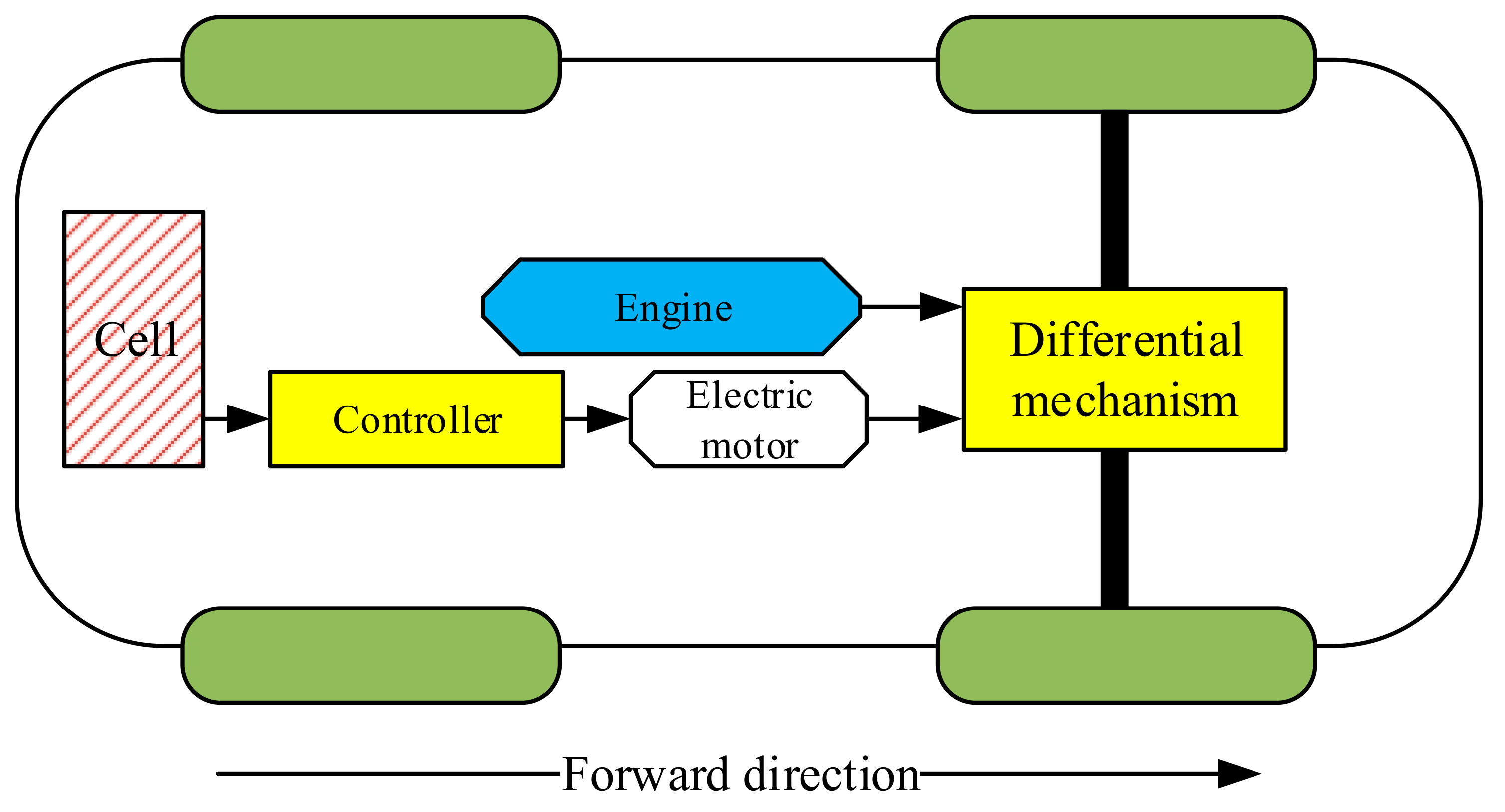
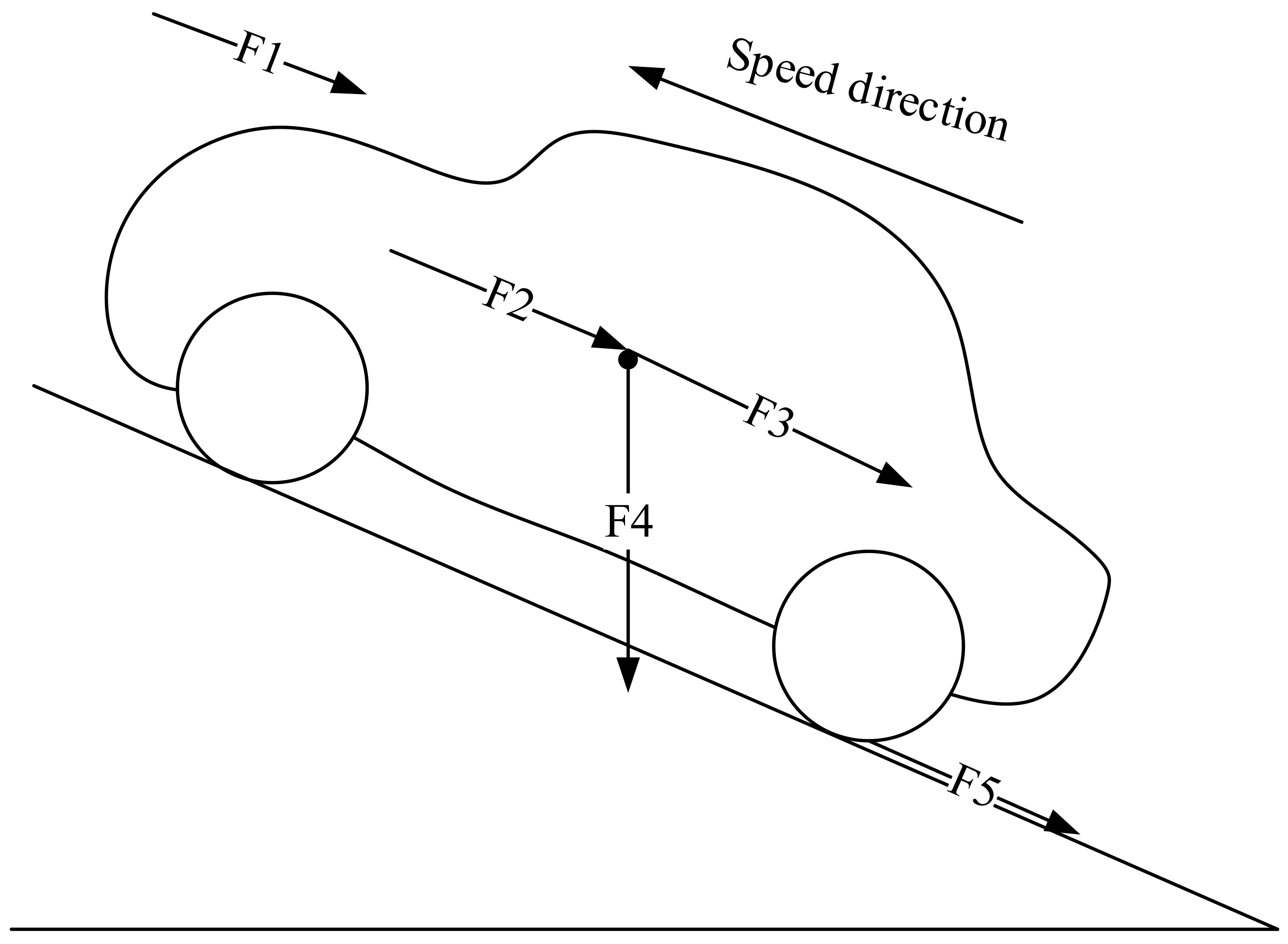

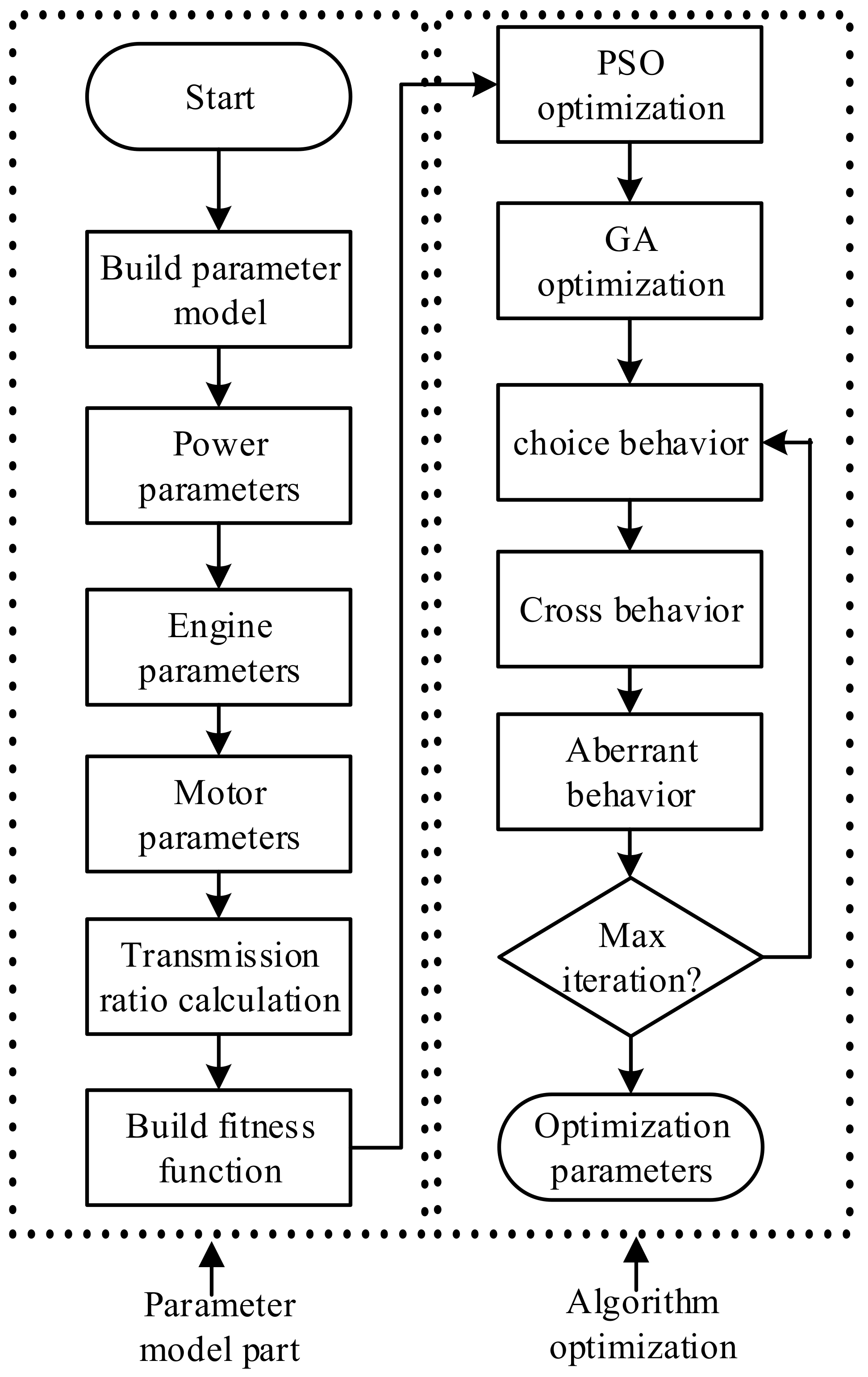
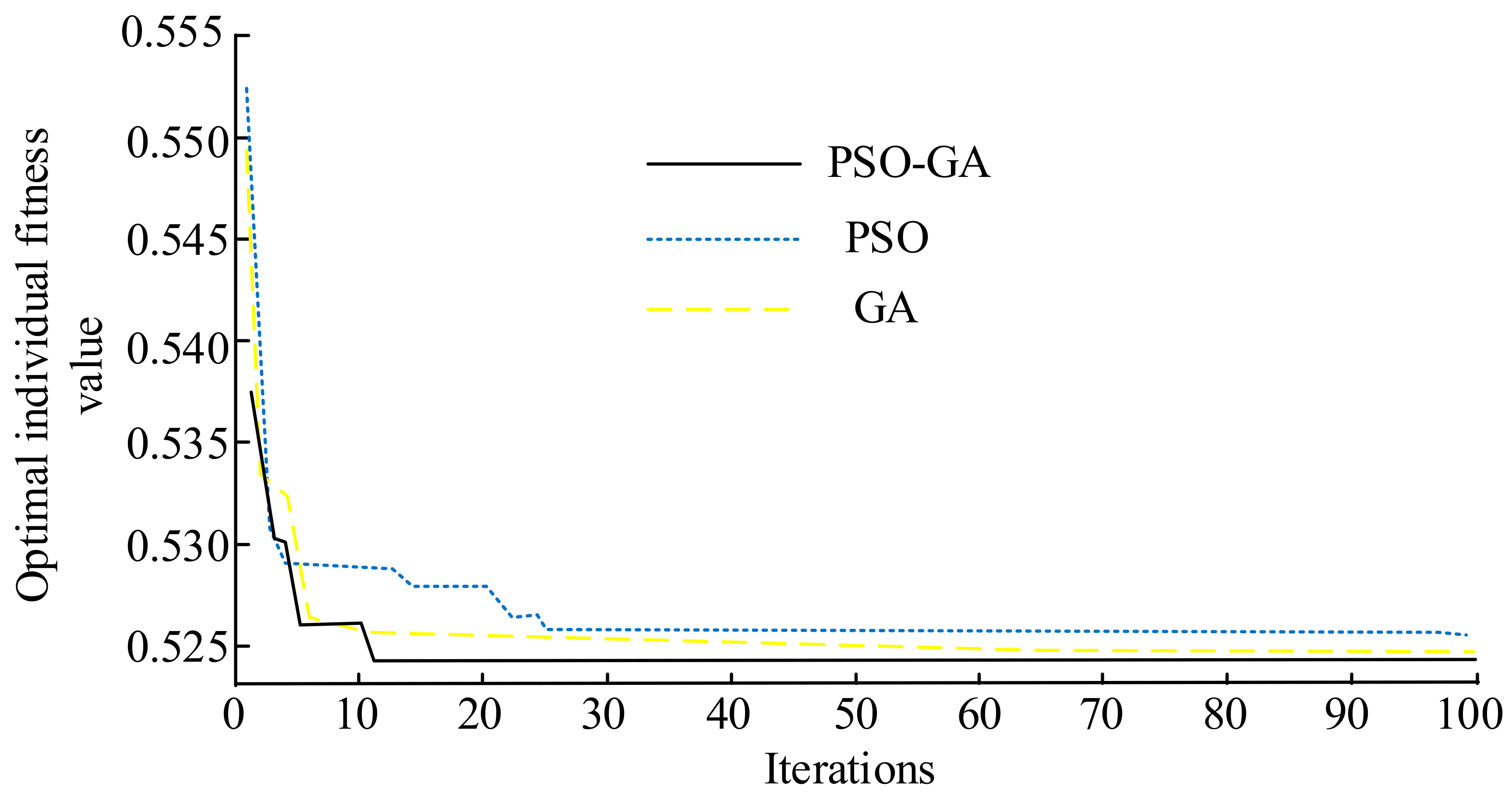
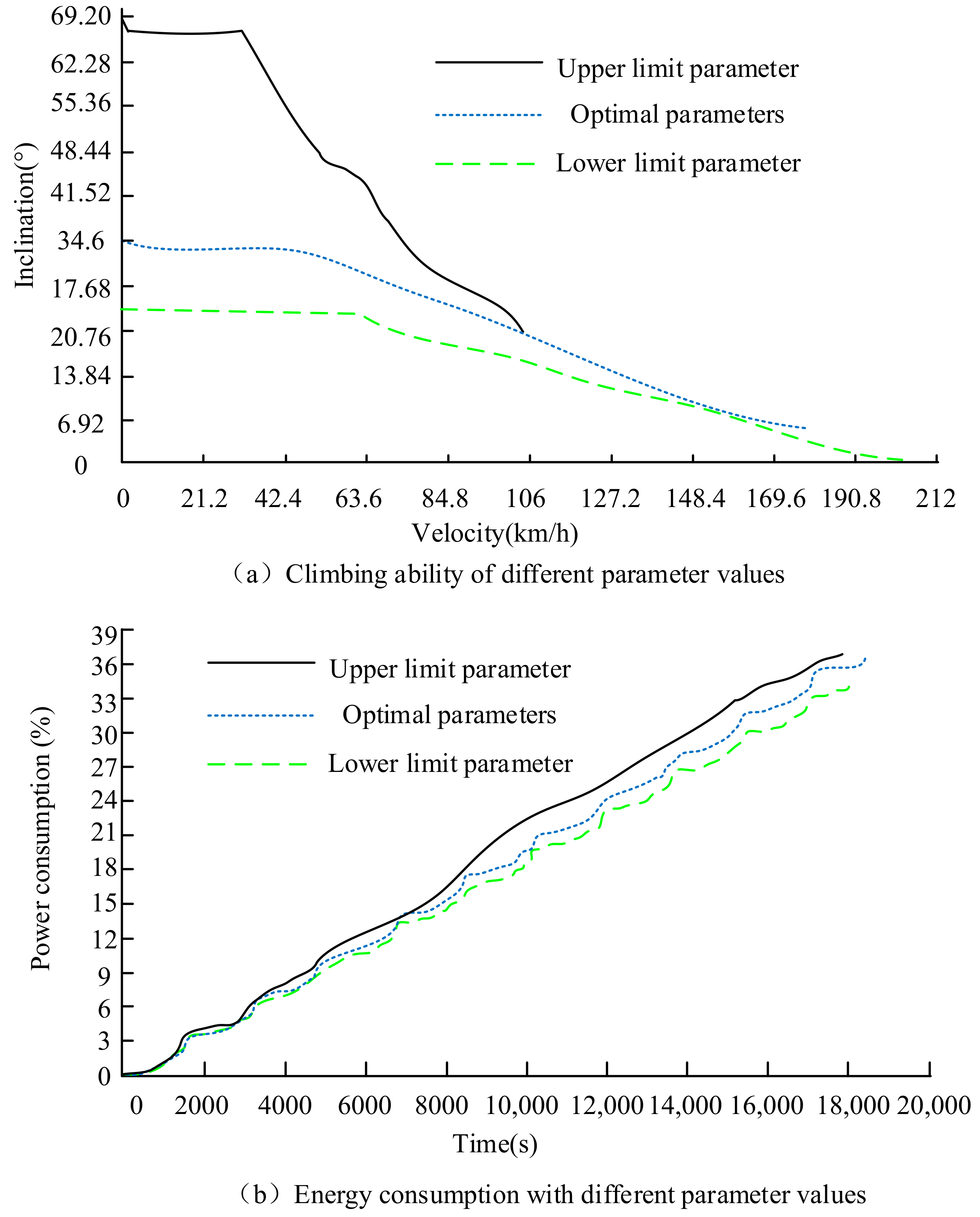



| Parameter Name | Character | Value and Value Range |
|---|---|---|
| Light weight | 1140 kg | |
| Drag coefficient | 0.312 | |
| Windward area | A | 2.05 m2 |
| Coefficient of rolling resistance | f | 0.0125 |
| Drive system efficiency | 0.915 | |
| Coefficient of moment of inertia | 1.08 | |
| Maximum speed | ≥150 km/h | |
| 0–100 km/h Acceleration time | / | 15 |
| 10 km/h Climbing performance | / | ≥20 |
| 60 km/h Operating range | / | ≥200 km |
| Tyre specification | / | 215/70 R16 |
| Velocity (km/h) | Time (s) | Distance (m) | Speed (1/min) |
|---|---|---|---|
| 10 | 0.8 | 1.11 | 568.41 |
| 20 | 0.6 | 4.44 | 1136.82 |
| 30 | 2.4 | 9.92 | 1705.23 |
| 40 | 3.2 | 17.79 | 2273.64 |
| 50 | 4.01 | 27.68 | 2842.05 |
| 60 | 4.83 | 40.37 | 3410.46 |
| 70 | 5.63 | 55.69 | 3978.87 |
| 80 | 6.55 | 73.90 | 4547.28 |
| 90 | 7.45 | 95.05 | 5115.69 |
| 100 | 8.4 | 120.3 | 5684.11 |
| 110 | 9.49 | 151.69 | 6252.52 |
| 120 | 10.72 | 191.33 | 6820.93 |
| 130 | 12.11 | 239.85 | 7389.34 |
| 140 | 13.74 | 299.76 | 7957.75 |
| 150 | 15.54 | 373.71 | 8526.16 |
| 160 | 17.67 | 465.54 | 9094.57 |
| 170 | 20.19 | 581.09 | 9662.98 |
| 180 | 23.24 | 729.38 | 10,231.39 |
| 190 | 27.06 | 925.79 | 10,799.8 |
| 200 | 32.12 | 1200.15 | 11,369.21 |
| 210 | 39.54 | 1623.54 | 11,936.62 |
| 220 | 53.45 | 2456.82 | 12,505.03 |
| Maximum Climbing Capacity | ||
|---|---|---|
| Max inclination (°) | Velocity (km/h) | Speed (1/min) |
| 35.73 | 10 | 398.87 |
| Measuring points speed | ||
| Speed (1/min) | Velocity (km/h) | Max inclination (°) |
| 0.00 | 0.00 | 36.54 |
| 866.67 | 15.25 | 35.73 |
| 5200 | 91.48 | 31.75 |
| 10,000 | 175.93 | 10.53 |
Disclaimer/Publisher’s Note: The statements, opinions and data contained in all publications are solely those of the individual author(s) and contributor(s) and not of MDPI and/or the editor(s). MDPI and/or the editor(s) disclaim responsibility for any injury to people or property resulting from any ideas, methods, instructions or products referred to in the content. |
© 2023 by the authors. Licensee MDPI, Basel, Switzerland. This article is an open access article distributed under the terms and conditions of the Creative Commons Attribution (CC BY) license (https://creativecommons.org/licenses/by/4.0/).
Share and Cite
Luo, D.; Ji, W.; Hu, X. Parameter Optimization and Control Strategy of Hybrid Electric Vehicle Transmission System based on Improved GA Algorithm. Processes 2023, 11, 1554. https://doi.org/10.3390/pr11051554
Luo D, Ji W, Hu X. Parameter Optimization and Control Strategy of Hybrid Electric Vehicle Transmission System based on Improved GA Algorithm. Processes. 2023; 11(5):1554. https://doi.org/10.3390/pr11051554
Chicago/Turabian StyleLuo, Daobao, Wujun Ji, and Xin Hu. 2023. "Parameter Optimization and Control Strategy of Hybrid Electric Vehicle Transmission System based on Improved GA Algorithm" Processes 11, no. 5: 1554. https://doi.org/10.3390/pr11051554
APA StyleLuo, D., Ji, W., & Hu, X. (2023). Parameter Optimization and Control Strategy of Hybrid Electric Vehicle Transmission System based on Improved GA Algorithm. Processes, 11(5), 1554. https://doi.org/10.3390/pr11051554






